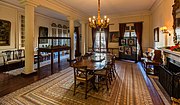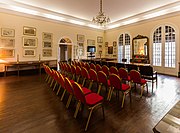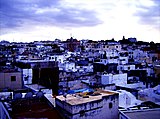American Legation | |
 Courtyard of the Legation | |
| Location | Tangier, Morocco |
|---|---|
| Coordinates | 35°47′02″N 5°48′38″W / 35.78398°N 5.81068°W |
| Built | 1821 |
| Architectural style | Moorish architecture |
| NRHP reference No. | 81000703 |
| Significant dates | |
| Added to NRHP | January 8, 1981 [1] |
| Designated NHL | December 17, 1982 [2] |
The Tangier American Legation ( Arabic: المفوضية الأميركية في طنجة; French: Légation américaine de Tanger), officially the Tangier American Legation Institute for Moroccan Studies (TALIMS), [3] is a building in the medina of Tangier, Morocco that formerly housed the United States diplomatic mission to Morocco. It was the first American public property abroad and is the only U.S. National Historic Landmark in a foreign country. [note 1]
The legation was established on May 17, 1821 following decades of cordial relations between the U.S. and Morocco; Sultan Mohammed ben Abdallah had issued a proclamation recognizing U.S. independence from Great Britain on December 20, 1777, making his nation the first to do so. [4] The building was gifted by the sultan to the U.S. government to serve as a diplomatic post, for which it remained for the next 140 years.
After Morocco's diplomatic capital moved to Rabat in 1956, the building served a variety of government functions, before gradually falling into neglect and disrepair. In 1976, former U.S. diplomats established the nonprofit Tangier American Legation Museum Society to restore and preserve the structure; [5] the site has since served as a cultural center, museum, and research library, concentrating on Arabic language studies.
The Tangier American Legation is considered a symbol of the historic cultural and diplomatic relations between the U.S. and the Kingdom of Morocco, [6] and of long-running American engagement with the wider Islamic world. [7] In recognition of its historic and cultural importance, the site was listed on the U.S. National Register of Historic Places in 1981 and designated a National Historic Landmark the following year; it is one of 39 properties owned by the U.S. Department of State listed in the Register of Culturally Significant Property.
Diplomatic history
The legation is an elaborate Moorish-style building of stuccoed masonry. This complex structure contains the two-story mud and stone building presented to the United States in 1821 by Sultan Moulay Suliman. The first property acquired abroad by the United States government, it housed the United States Legation and Consulate for 140 years, the longest period any building abroad has been occupied as a United States diplomatic post.[ citation needed] It is symbolic of the 1786 Moroccan–American Treaty of Friendship, which is still in force today. The complex expanded over the years as the surrounding houses were bought up. During World War II it served as headquarters for United States intelligence agents.[ citation needed]
After the move to Rabat as the diplomatic capital in 1956, when the country gained its independence, the Legation was abandoned as a diplomatic building. Over the years the United States government proceeded to use it as consul offices and Peace Corps offices, among other things. In time it became neglected and threatened with demolition. [8]
Present
In 1976 a group of American citizens established a public, non-profit organization to save the Old American Legation (as it is known locally). Today the Tangier American Legation Museum Society rents the structure, which is still owned by the United States government.
The Tangier American Legation Institute for Moroccan Studies (TALIM) is a museum and cultural center for the study of Morocco and Morocco–United States relations, and it has many paintings by Marguerite McBey and other artists. In 2010, TALIM expanded the original Paul Bowles room to The Paul Bowles Wing, three rooms devoted to the expatriate writer and composer Paul Bowles. In 1999, the Legation received its initial donation of furniture, photographs and documents for the original Paul Bowles Room compiled by Gloria Kirby, a permanent resident of Tangier and friend of Bowles. [9] The museum also has a research library and conference room. TALIM's community outreach programs include Arabic literacy courses for women living in the Tangier medina. Jen Rasamimanana is the current museum director.
Gallery
See also
Notes
- ^ Excluding those in countries that grew out of the Trust Territory of the Pacific Islands.
References
- ^ "National Register Information System". National Register of Historic Places. National Park Service. January 23, 2007.
- ^ "American Legation". National Historic Landmark summary listing. National Park Service. Archived from the original on 11 October 2007. Retrieved 2007-10-12.
- ^ "American History on Foreign Soil: The Tangier American Legation in Morocco | National Trust for Historic Preservation". savingplaces.org. Retrieved 2022-04-06.
- ^ "Morocco". United States Department of State. Retrieved 2022-09-21.
- ^ Cornwell, Graham. "Why a 200-Year-Building in Morocco Is the Only National Historic Landmark Outside the U.S." Smithsonian Magazine. Retrieved 2022-04-06.
- ^ "Ambassador and Mrs. Fischer at the American Legation building in the medina of Tangier, Morocco". U.S. Embassy Rabat. U.S. Embassy & Consulate in Morocco. 2020-12-02. Archived from the original on 2020-12-15. Retrieved 2020-12-15.
- ^ "American History on Foreign Soil: The Tangier American Legation in Morocco | National Trust for Historic Preservation". savingplaces.org. Retrieved 2022-04-06.
- ^ "Tangier American Legation Museum". Atlas Obscura. Retrieved 2022-04-06.
- ^ "Paul Bowles Wing: Tangier American Legation (TALIM)". www.paulbowles.org. Archived from the original on 2019-12-27. Retrieved 2019-03-27.
External links
- 1821 establishments in the United States
- Defunct diplomatic missions of the United States
- History museums in Morocco
- Buildings and structures in Tangier
- National Historic Landmarks of the United States
- Register of Culturally Significant Property
- Morocco–United States relations
- Arab studies
- Diplomatic missions in Morocco
- Tourist attractions in Tangier
- 1821 establishments in Morocco
- 19th-century architecture in Morocco






